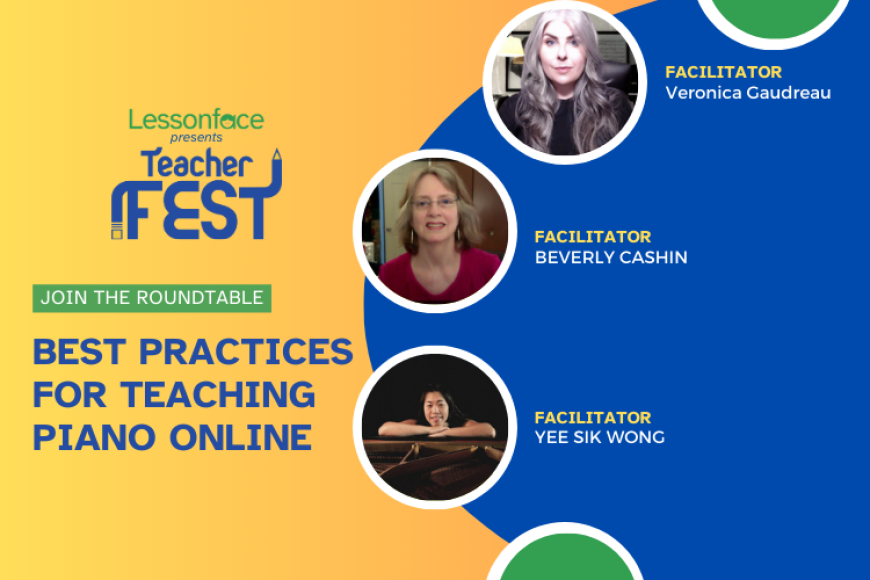Best Practices for Teaching Piano Online Recap

Thanks so much to amazing piano instructors Beverly Cashin, Yee-Sik Wong and Veronica Gaudreau for sharing their experience and insights as part of Lessonface’s 2023 TeacherFest roundtable on Best Practices for Teaching Piano at Lessonface.
The three facilitators collaborated to create a list of helpful topics. Here’s a recap of the information shared:
Tips for students who don’t practice
We all have students who don’t practice. So, what are some solutions to keep us inspired to teach and students motivated to practice?
Beverly suggests using the lesson time as a practice session! She emails each student’s practice routine and going over these during the lesson can be very beneficial to ensure students understand how to practice and for the teacher to assess student’s practice habits.
What if they still don’t practice?
- For young students, Beverly suggests emailing the parent to check-in and see if they can find a solution.
- If that still doesn’t work and the lesson becomes draining, then she reaches out to the adult student or parent to see what may be the best plan moving forward.
Yee-Sik says for her adult students, she follows a similar protool, since she understands her adult students have limited time to practice, and so practicing during the lesson works well for everyone: teacher and student! For younger, Yee-Ski has found success messaging the parents to keep them involved in their child’s practice schedule.
Veronica also suggests practicing with them during the lesson and learning part of a song by rote during the lesson is helpful so they are able to play a melody or fun part of the song to encourage them to continue to practice/play at home.
Beverly brings a great point that sometimes students don’t know how to practice. She suggests showing them how to practice during the lesson has proven beneficial!
How long should students practice?
It really varies from student to student and their practice plan and how each teacher assesses the best way to practice.
Beverly doesn’t make it time specific. Instead, she emails the student a summary of what they should practice during the week. This allows them to focus on what to practice, not so much how long they practice. As long as they follow the summary, then they can use the rest of the time to play anything they’d like (i.e. learn new songs on their own, explore the piano, compose songs, etc).
Yee-Sik shares with her adult/older students to practice for 20-30 minutes, since most of them have to work, the time-bound practice works well for them!
Technology in Lessons
Veronica suggests at the most basic level, their instrument (piano) and a device for camera (phone, tablet or computer) is the minimum for an online lesson. She highly recommends a good microphone, as sound is an essential part of music learning, not only for the instrument but also so that the communication between teacher and student is very clear. In some cases, if the student's sound is difficult to listen to, she may recommend an external microphone.
Veronica’s equipment suggestions for teachers:
- Good lighting -> this will give a nice clear picture for the student
- OBS (https://obsproject.com/) - Free App
- Chordie (https://www.chordieapp.com/)
- Multi camera angles (It's beneficial when teaching piano to have a camera on your face, and a camera for an overhead view of your piano)
- A good external microphone
- Using Preview to make notes right on the page or use Zoom’s whiteboard
- Sharing sound via MIDI through Jux Audio unit Hosting (https://ju-x.com/hostingau.html) Free App. It needs a host to produce the sound.
Veronica also uses the ‘Notes’ app on her Mac to take her lesson notes, and has electronic folders for each student to easily access electronic student materials, such as song PDF’s. This allows her to make notes right on the PDF for the student to see.
We briefly discussed latency issues during lessons. Philip mentioned a fun fact that if both the student and teacher have fiber internet connection that it could work to play simultaneously during the lesson. Other more common options Beverly mentioned was to have backing tracks with a file for students to play along.
Do you communicate with your students before the first lesson?
This was really interesting because they each had a unique way to handle the initial process of lessons. Yee Sik suggests touching base with them before in order to better prepare for the lesson. Beverly shared how she has a template she uses and sends to each student when they first book a lesson. Veronica prefers to use the first lesson to test equipment, ask their interests and goals with piano.
Adults who don’t practice nor take your advice & how to handle
As mentioned above, Beverly suggests using the lesson time as practice. She also shares that learning piano is a great way to keep expanding your brain as we grow older. Sometimes having an honest conversation with the student can also be beneficial.
Veronica suggests asking them questions about what they are playing, so that they notice their ‘mistakes’ and feel a little more independent in their learning.
Sonnie shared a great experience with her students, that oftentimes we can ask what they can do and work backwards to design their lesson plans based on how much practice time they have.
Pop music vs Classical - Repertoire Choice
Sonnie asked a great question on what are the best ways to handle pop repertoire, especially songs which may not translate well into piano. Veronica says there’s a lot to learn from pop music as well as classical. Along the same lines, Beverly shares how she sees them as two branches of learning music, and pointed out how pop music can be great for music theory. One note of caution, Beverly says, is to make sure to find a version of the song that students are actually able to play, while also adding a more traditional second song for the student’s technique. They all agreed that there’s much to be learned from both avenues!
Do you write and/or arrange music for your students?
Veronica says she often does that in her teachings, since it allows her to cater the level of a song version to each student. Students appreciate having a version just for them. Isabella Mendes shares that arranging a version of a song can be done together with the student as a form of a theory exercise.
How to obtain and retain students?
Beverly suggests having good policy and etiquette practice with students in terms of rescheduling and cancellation can influence student retention. Given the 24-hour cancellation policy, she says sometimes she may reschedule if there are unforeseen circumstances. By showing flexibility and understanding, students are more likely to continue lessons.
Yee-Sik agrees that it’s good to have flexibility in that matter too. In case of a cancellation, Veronica uses their lesson time to create a video tutorial and asks students if there’s anything specific they want her to cover. Isabella shares the importance of creating a relationship with the students and their parents. Being understanding while still holding your policy can go a long way, and it may inspire them to give you referrals.
Sonnie shares a great tip on reaching out to students when there are some milestones, like back to school, or offering promotions and special events, as a good way to stay in touch and encourage them to return and/or continue with the lessons.
Comments and Discussion
Lessonface teachers can join the discussion on this topic at the Teacher's Lounge.
Not a Lessonface teacher? Click here to learn more about teaching on Lessonface.




